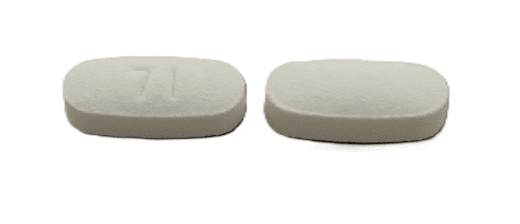Boxed Warning
Fetal toxicity:
Drugs that act directly on the renin-angiotensin system can cause injury and death to the developing fetus. When pregnancy is detected, discontinue sacubitril/valsartan as soon as possible.
Dosage Forms
Excipient information presented when available (limited, particularly for generics); consult specific product labeling.
Tablet, Oral:
Entresto: Sacubitril 24 mg and valsartan 26 mg, Sacubitril 49 mg and valsartan 51 mg, Sacubitril 97 mg and valsartan 103 mg
Pharmacology
Mechanism of Action
Sacubitril: Prodrug that inhibits neprilysin (neutral endopeptidase) through the active metabolite LBQ657, leading to increased levels of peptides, including natriuretic peptides; induces vasodilation and natriuresis (Hubers 2016).
Valsartan: Produces direct antagonism of the angiotensin II (AT2) receptors. Displaces angiotensin II from the AT1 receptor; antagonizes AT1-induced vasoconstriction, aldosterone release, catecholamine release, arginine vasopressin release, water intake, and hypertrophic responses.
Pharmacokinetics/Pharmacodynamics
Distribution
Vd: Sacubitril: 103 L; Valsartan: 75 L
Metabolism
Sacubitril: Converted to active metabolite LBQ657 by esterases; LBQ657 is not further metabolized to a significant extent
Valsartan: Minimally metabolized (~20%; <10% as a hydroxyl metabolite)
Excretion
Sacubitril: Urine (52% to 68%, primarily as LBQ657); feces (37% to 48%, primarily as LBQ657)
Valsartan: Urine (~13%, parent drug and metabolites); feces (86%, parent drug and metabolites)
Time to Peak
Sacubitril: 0.5 hours; LBQ657: 2 hours; Valsartan: 1.5 hours
Half-Life Elimination
Sacubitril: 1.4 hours; LBQ657: 11.5 hours; Valsartan: 9.9 hours
Protein Binding
94% to 97%
Use: Labeled Indications
Heart failure:
Adult: Reduce the risk of cardiovascular death and hospitalization for heart failure (HF) in patients with chronic HF (New York Heart Association Class II-IV) and reduced ejection fraction; usually administered in conjunction with other HF therapies, in place of an angiotensin-converting enzyme inhibitor or other angiotensin II receptor blocker.
Pediatric: Treatment of symptomatic HF with systemic left ventricular systolic dysfunction in pediatric patients ≥1 year of age.
Contraindications
Hypersensitivity to sacubitril, valsartan, or any component of the formulation; history of angioedema related to previous ACE inhibitor or ARB therapy; concomitant use or use within 36 hours of ACE inhibitors; concomitant use of aliskiren in patients with diabetes
According to the ACC/AHA/HFSA guidelines, the use of sacubitril/valsartan is contraindicated in patients with a history of angioedema, regardless of cause (ACC/AHA/HFSA [Yancy 2016]).
Canadian labeling: Additional contraindications (not in US labeling): Recent symptomatic hypotension prior to initiation of treatment with sacubitril/valsartan; concomitant use of aliskiren in patients with moderate to severe renal impairment (eGFR <60 mL/minute/1.73 m2); pregnancy; breastfeeding.
Dosage and Administration
Dosing: Adult
Note: Entresto contains sacubitril (24 mg, 49 mg, or 97 mg) and valsartan (26 mg, 51 mg, or 103 mg). Use caution when prescribing since dosing in clinical trials was based on the total amount of both components (ie, 24/26 mg, 49/51 mg and 97/103 mg were referred to as 50 mg, 100 mg, and 200 mg, respectively). To reduce the risk of errors, include the doses of both ingredients (eg, Entresto 24/26 mg) when prescribing Entresto. The valsartan in Entresto is more bioavailable than the valsartan in other marketed tablet formulations; valsartan 26 mg, 51 mg, and 103 mg in Entresto is equivalent to valsartan 40 mg, 80 mg, and 160 mg in other marketed tablet formulations, respectively.
Heart failure: Oral:
Note: Concomitant use of an angiotensin-converting enzyme (ACE) inhibitor is contraindicated; allow a 36-hour washout period when switching from or to an ACE inhibitor. Only consider initiation in hemodynamically stable patients with systolic BP ≥100 mm Hg (McMurray 2014).
Patients previously taking a moderate to high dose ACE inhibitor (ie, >10 mg/day of enalapril or equivalent) or angiotensin II receptor blocker (ie, >160 mg/day of valsartan or equivalent): Initial: Sacubitril 49 mg/valsartan 51 mg twice daily. Double the dose as tolerated after 2 to 4 weeks to the target maintenance dose of sacubitril 97 mg/valsartan 103 mg twice daily.
Patients previously taking low doses of an ACE inhibitor (ie, ≤10 mg/day of enalapril or equivalent) or ARB (ie, ≤160 mg/day of valsartan or equivalent): Initial: Sacubitril 24 mg/valsartan 26 mg twice daily. Double the dose as tolerated every 2 to 4 weeks to the target maintenance dose of sacubitril 97 mg/valsartan 103 mg twice daily.
Patients not currently taking an ACE inhibitor or an ARB: Initial: Sacubitril 24 mg/valsartan 26 mg twice daily. Double the dose as tolerated every 2 to 4 weeks to the target maintenance dose of sacubitril 97 mg/valsartan 103 mg twice daily.
Dosing: Geriatric
Refer to adult dosing.
Dosing: Pediatric
Note: Entresto is a combination of sacubitril and valsartan. Use extra precautions when dosing. Dosing for the oral suspension is presented as the combined mg dose of sacubitril and valsartan. Dosing for the oral tablet is presented as the individual mg for each component.
An oral suspension may be extemporaneously prepared. The sacubitril:valsartan ratio varies slightly with each tablet strength; only the 49/51 mg tablets can be used to compound the oral suspension to achieve a combined sacubitril and valsartan concentration of 4 mg/mL (sacubitril 1.96 mg and valsartan 2.04 mg/mL) (see Extemporaneous Preparations). If switching between oral suspension and tablets, consider available strengths and adjust dose as needed.
The valsartan in Entresto is more bioavailable than the valsartan in other marketed tablet formulations; valsartan 26 mg, 51 mg, and 103 mg in Entresto is equivalent to valsartan 40 mg, 80 mg, and 160 mg in other marketed tablet formulations, respectively.
Heart failure, treatment: Note: Concomitant use of an angiotensin-converting enzyme (ACE) inhibitor is contraindicated; allow a 36-hour washout period when switching from or to an ACE inhibitor.
Patients previously taking a moderate to high dose ACE inhibitor (ie, ≥0.2 mg/kg/day or 10 mg/day of enalapril or equivalent) or angiotensin II receptor blocker (ARB):
Oral suspension (see Extemporaneous Preparations): Note: Dose presented as the combined mg dose of sacubitril and valsartan.
Children and Adolescents weighing <40 kg: Oral: Initial: 1.6 mg/kg/dose twice daily; titrate dose in 2 weeks to 2.3 mg/kg/dose twice daily, then 2 weeks later to 3.1 mg/kg/dose twice daily.
Tablets: Children and Adolescents:
40 to <50 kg: Oral: Initial: Sacubitril 24 mg/valsartan 26 mg twice daily; titrate dose in 2 weeks to sacubitril 49 mg/valsartan 51 mg twice daily, then 2 weeks later to sacubitril 72 mg/valsartan 78 mg (three 24/26 mg tablets) twice daily.
≥50 kg: Oral: Initial: Sacubitril 49 mg/valsartan 51 mg twice daily; titrate dose in 2 weeks to sacubitril 72 mg/valsartan 78 mg (three 24/26 mg tablets) twice daily, then 2 weeks later to sacubitril 97 mg/valsartan 103 mg twice daily.
Patients not currently taking an ACE inhibitor or an ARB or previously taking low doses of an ACE inhibitor (ie, 0.1 mg/kg/day or 5 mg/day of enalapril or equivalent) or ARB:
Oral suspension (see Extemporaneous Preparations): Note: Dose presented as the combined mg dose of sacubitril and valsartan.
Children and Adolescents weighing ≤50 kg: Oral: Initial: 0.8 mg/kg/dose twice daily; titrate dose in 2 weeks to 1.6 mg/kg/dose twice daily, then 2 weeks later to 2.3 mg/kg/dose twice daily, then 2 weeks later to 3.1 mg/kg/dose twice daily.
Tablets: Children and Adolescents weighing >50 kg: Oral: Initial: Sacubitril 24 mg/valsartan 26 mg twice daily; titrate dose in 2 weeks to sacubitril 49 mg/valsartan 51 mg twice daily, then 2 weeks later to sacubitril 72 mg/valsartan 78 mg (three 24/26 mg tablets) twice daily, then 2 weeks later to sacubitril 97 mg/valsartan 103 mg twice daily.
Extemporaneously Prepared
4 mg (sacubitril 1.96 mg and valsartan 2.04 mg)/mL Oral Suspension
Note: This sacubitril:valsartan ratio is only provided when the 49/51 mg tablets are used in preparing the extemporaneous oral suspension.
A 4 mg (sacubitril 1.96 mg and valsartan 2.04 mg)/mL oral suspension may be made with 49/51 mg tablets, Ora-Plus, and Ora-Sweet SF. Crush eight 49/51 mg tablets in a mortar and reduce to a fine powder. Add 60 mL of Ora-Plus and gently mix for 10 minutes to form a uniform suspension. Then, add 140 mL of Ora-Sweet SF and mix for another 10 minutes to form a uniform suspension. Transfer to a 200 mL amber colored PET or glass bottle. Label "shake well". Stable for up to 15 days when stored at room temperature (≤25°C [77°F]). Do not refrigerate.
Entresto (sacubitril/valsartan) [prescribing information]. East Hanover, NJ: Novartis; October 2019.
Administration
Oral: Administer with or without food.
Storage
Store at 20°C to 25°C (68°F to 77°F); excursions permitted between 15°C and 30°C (59°F and 86°F). Protect from moisture.
Sacubitril and Valsartan Images
Drug Interactions
Alfuzosin: May enhance the hypotensive effect of Blood Pressure Lowering Agents. Monitor therapy
Aliskiren: May enhance the hyperkalemic effect of Angiotensin II Receptor Blockers. Aliskiren may enhance the hypotensive effect of Angiotensin II Receptor Blockers. Aliskiren may enhance the nephrotoxic effect of Angiotensin II Receptor Blockers. Management: Aliskiren use with ACEIs or ARBs in patients with diabetes is contraindicated. Combined use in other patients should be avoided, particularly when CrCl is less than 60 mL/min. If combined, monitor potassium, creatinine, and blood pressure closely. Consider therapy modification
Amifostine: Blood Pressure Lowering Agents may enhance the hypotensive effect of Amifostine. Management: When amifostine is used at chemotherapy doses, blood pressure lowering medications should be withheld for 24 hours prior to amifostine administration. If blood pressure lowering therapy cannot be withheld, amifostine should not be administered. Consider therapy modification
Amphetamines: May diminish the antihypertensive effect of Antihypertensive Agents. Monitor therapy
Angiotensin II: Receptor Blockers may diminish the therapeutic effect of Angiotensin II. Monitor therapy
Angiotensin-Converting Enzyme Inhibitors: May enhance the adverse/toxic effect of Sacubitril. Specifically, the risk of angioedema may be increased with this combination. Avoid combination
Antihepaciviral Combination Products: May increase the serum concentration of Valsartan. Management: Per antihepaciviral combination product US prescribing information, consider decreasing the valsartan dose and monitoring for evidence of hypotension and worsening renal function if these agents are used in combination. Consider therapy modification
Antipsychotic Agents (Second Generation [Atypical]): Blood Pressure Lowering Agents may enhance the hypotensive effect of Antipsychotic Agents (Second Generation [Atypical]). Monitor therapy
Barbiturates: May enhance the hypotensive effect of Blood Pressure Lowering Agents. Monitor therapy
Benperidol: May enhance the hypotensive effect of Blood Pressure Lowering Agents. Monitor therapy
Blood Pressure Lowering Agents: May enhance the hypotensive effect of Hypotension-Associated Agents. Monitor therapy
Brigatinib: May diminish the antihypertensive effect of Antihypertensive Agents. Brigatinib may enhance the bradycardic effect of Antihypertensive Agents. Monitor therapy
Brimonidine (Topical): May enhance the hypotensive effect of Blood Pressure Lowering Agents. Monitor therapy
Bromperidol: Blood Pressure Lowering Agents may enhance the hypotensive effect of Bromperidol. Bromperidol may diminish the hypotensive effect of Blood Pressure Lowering Agents. Avoid combination
CycloSPORINE (Systemic): Angiotensin II Receptor Blockers may enhance the hyperkalemic effect of CycloSPORINE (Systemic). Monitor therapy
Dapoxetine: May enhance the orthostatic hypotensive effect of Angiotensin II Receptor Blockers. Monitor therapy
Dexmethylphenidate: May diminish the therapeutic effect of Antihypertensive Agents. Monitor therapy
Diazoxide: May enhance the hypotensive effect of Blood Pressure Lowering Agents. Monitor therapy
Drospirenone: Angiotensin II Receptor Blockers may enhance the hyperkalemic effect of Drospirenone. Monitor therapy
DULoxetine: Blood Pressure Lowering Agents may enhance the hypotensive effect of DULoxetine. Monitor therapy
Eltrombopag: May increase the serum concentration of OATP1B1/1B3 (SLCO1B1/1B3) Substrates. Monitor therapy
Eplerenone: May enhance the hyperkalemic effect of Angiotensin II Receptor Blockers. Monitor therapy
Gemfibrozil: May increase the serum concentration of OATP1B1/1B3 (SLCO1B1/1B3) Substrates. See separate drug interaction monographs for agents listed as exceptions. Monitor therapy
Heparin: May enhance the hyperkalemic effect of Angiotensin II Receptor Blockers. Monitor therapy
Heparins (Low Molecular Weight): May enhance the hyperkalemic effect of Angiotensin II Receptor Blockers. Monitor therapy
Herbs (Hypertensive Properties): May diminish the antihypertensive effect of Antihypertensive Agents. Monitor therapy
Herbs (Hypotensive Properties): May enhance the hypotensive effect of Blood Pressure Lowering Agents. Monitor therapy
HydroCHLOROthiazide: May enhance the hypotensive effect of Valsartan. Valsartan may increase the serum concentration of HydroCHLOROthiazide. Monitor therapy
Hypotension-Associated Agents: Blood Pressure Lowering Agents may enhance the hypotensive effect of Hypotension-Associated Agents. Monitor therapy
Levodopa-Containing Products: Blood Pressure Lowering Agents may enhance the hypotensive effect of Levodopa-Containing Products. Monitor therapy
Lithium: Angiotensin II Receptor Blockers may increase the serum concentration of Lithium. Management: Lithium dosage reductions will likely be needed following the addition of an angiotensin II receptor antagonist. Consider therapy modification
Lormetazepam: May enhance the hypotensive effect of Blood Pressure Lowering Agents. Monitor therapy
Methylphenidate: May diminish the antihypertensive effect of Antihypertensive Agents. Monitor therapy
Molsidomine: May enhance the hypotensive effect of Blood Pressure Lowering Agents. Monitor therapy
Naftopidil: May enhance the hypotensive effect of Blood Pressure Lowering Agents. Monitor therapy
Nicergoline: May enhance the hypotensive effect of Blood Pressure Lowering Agents. Monitor therapy
Nicorandil: May enhance the hyperkalemic effect of Angiotensin II Receptor Blockers. Monitor therapy
Nicorandil: May enhance the hypotensive effect of Blood Pressure Lowering Agents. Monitor therapy
Nitroprusside: Blood Pressure Lowering Agents may enhance the hypotensive effect of Nitroprusside. Monitor therapy
Nonsteroidal Anti-Inflammatory Agents: Angiotensin II Receptor Blockers may enhance the adverse/toxic effect of Nonsteroidal Anti-Inflammatory Agents. Specifically, the combination may result in a significant decrease in renal function. Nonsteroidal Anti-Inflammatory Agents may diminish the therapeutic effect of Angiotensin II Receptor Blockers. The combination of these two agents may also significantly decrease glomerular filtration and renal function. Monitor therapy
Obinutuzumab: May enhance the hypotensive effect of Blood Pressure Lowering Agents. Management: Consider temporarily withholding blood pressure lowering medications beginning 12 hours prior to obinutuzumab infusion and continuing until 1 hour after the end of the infusion. Consider therapy modification
Pentoxifylline: May enhance the hypotensive effect of Blood Pressure Lowering Agents. Monitor therapy
Pholcodine: Blood Pressure Lowering Agents may enhance the hypotensive effect of Pholcodine. Monitor therapy
Phosphodiesterase 5 Inhibitors: May enhance the hypotensive effect of Blood Pressure Lowering Agents. Monitor therapy
Potassium Salts: May enhance the hyperkalemic effect of Angiotensin II Receptor Blockers. Monitor therapy
Potassium-Sparing Diuretics: Angiotensin II Receptor Blockers may enhance the hyperkalemic effect of Potassium-Sparing Diuretics. Monitor therapy
Prostacyclin Analogues: May enhance the hypotensive effect of Blood Pressure Lowering Agents. Monitor therapy
Quinagolide: May enhance the hypotensive effect of Blood Pressure Lowering Agents. Monitor therapy
Ranolazine: May enhance the adverse/toxic effect of Angiotensin II Receptor Blockers. Monitor therapy
Sodium Phosphates: Angiotensin II Receptor Blockers may enhance the nephrotoxic effect of Sodium Phosphates. Specifically, the risk of acute phosphate nephropathy may be enhanced. Management: Consider avoiding this combination by temporarily suspending treatment with ARBs, or seeking alternatives to oral sodium phosphate bowel preparation. If the combination cannot be avoided, maintain adequate hydration and monitor renal function closely. Consider therapy modification
Tacrolimus (Systemic): Angiotensin II Receptor Blockers may enhance the hyperkalemic effect of Tacrolimus (Systemic). Monitor therapy
Teriflunomide: May increase the serum concentration of OATP1B1/1B3 (SLCO1B1/1B3) Substrates. Monitor therapy
Tolvaptan: May increase the serum concentration of OATP1B1/1B3 (SLCO1B1/1B3) Substrates. Consider therapy modification
Trimethoprim: May enhance the hyperkalemic effect of Angiotensin II Receptor Blockers. Monitor therapy
Yohimbine: May diminish the antihypertensive effect of Antihypertensive Agents. Monitor therapy
Adverse Reactions
Also see individual agents.
>10%:
Cardiovascular: Hypotension (18%)
Endocrine & metabolic: Increased serum potassium (4% to 16%), hyperkalemia (12%)
Renal: Increased serum creatinine (2% to 16%)
1% to 10%:
Cardiovascular: Orthostatic hypotension (2%)
Central nervous system: Dizziness (6%), falling (2%)
Hematologic & oncologic: Decreased hematocrit (≤5%), decreased hemoglobin (≤5%)
Hypersensitivity: Angioedema (black patients: 2%; others: <1%)
Renal: Renal failure (5%)
Respiratory: Cough (9%)
<1%, postmarketing and/or case reports: Anaphylaxis, hypersensitivity, pruritus, skin rash
Warnings/Precautions
Concerns related to adverse effects:
- Angioedema: Angioedema has been reported rarely with some angiotensin II receptor antagonists (ARBs) and may occur at any time during treatment (especially following first dose). It may involve the head and neck (potentially compromising airway) or the intestine (presenting with abdominal pain). Prolonged frequent monitoring may be required, especially if tongue, glottis, or larynx are involved, because they are associated with airway obstruction and may be fatal. Patients with a history of airway surgery may have a higher risk of airway obstruction. Discontinue therapy immediately if angioedema occurs and do not readminister. Aggressive early management is critical. IM administration of epinephrine may be necessary. Patients with a history of angioedema may be at increased risk. Higher rates of angioedema may occur in black than in non-black patients. Do not administer sacubitril/valsartan to patients with history of hereditary angioedema or angioedema associated with an ACE inhibitor or ARB.
- Hyperkalemia: May occur; risk factors include renal dysfunction, diabetes mellitus, hypoaldosteronism, high potassium diet, concomitant use of aliskiren (contraindicated), potassium-sparing diuretics, potassium supplements, and/or potassium containing salts. Use cautiously, if at all, with these agents and monitor potassium closely.
- Hypotension: During the initiation of therapy, hypotension may occur, particularly in patients with heart failure or post-MI patients. Symptomatic hypotension may occur upon initiation in patients who are salt- or volume-depleted (eg, those treated with high-dose diuretics); correct salt or volume depletion prior to administration or initiate at a lower dose. This transient hypotensive response is not a contraindication to further treatment with sacubitril and valsartan.
- Renal function deterioration: May be associated with deterioration of renal function and/or increases in serum creatinine, particularly in patients with low renal blood flow (eg, renal artery stenosis, heart failure) whose glomerular filtration rate (GFR) is dependent on efferent arteriolar vasoconstriction by angiotensin II; deterioration may result in oliguria, acute renal failure, and progressive azotemia. Small increases in serum creatinine may occur following initiation; consider discontinuation only in patients with progressive and/or significant deterioration in renal function.
Disease-related concerns:
- Aortic/mitral stenosis: Use with caution in patients with significant aortic/mitral stenosis.
- Heart failure: Use caution when initiating in heart failure; may need to adjust dose, and/or concurrent diuretic therapy, because of hypotension. Careful monitoring of BUN, serum creatinine, and potassium is necessary especially if preexisting renal disease exists.
- Hepatic impairment: Use with caution and reduce dosage in patients with moderate hepatic impairment; use is not recommended in patients with severe hepatic impairment.
- Renal artery stenosis: Use with caution in patients with unstented unilateral/bilateral renal artery stenosis. When unstented bilateral renal artery stenosis is present, use is generally avoided due to the elevated risk of deterioration in renal function unless possible benefits outweigh risks.
- Renal impairment: Use with caution in preexisting renal insufficiency; reduce initial dosage for severe impairment (eGFR <30 mL/minute/1.73 m2).
Concurrent drug therapy issues:
- Drug-drug interactions: Potentially significant interactions may exist, requiring dose or frequency adjustment, additional monitoring, and/or selection of alternative therapy. Consult drug interactions database for more detailed information.
Special populations:
- Pregnancy: [US Boxed Warning]: Drugs that act directly on the renin-angiotensin system can cause injury and death to the developing fetus. When pregnancy is detected, discontinue sacubitril/valsartan as soon as possible.
- Surgical patients: In patients on chronic angiotensin receptor blocker (ARB) therapy, intraoperative hypotension may occur with induction and maintenance of general anesthesia; however, discontinuation of therapy prior to surgery is controversial. If continued preoperatively, avoidance of hypotensive agents during surgery is prudent (Hillis 2011).
Monitoring Parameters
Baseline and periodic serum potassium, renal function, BP.
2013 ACCF/AHA Heart Failure guideline recommendations: Within 1 to 2 weeks after initiation of an ARB, reassess blood pressure (including postural blood pressure changes), renal function, and serum potassium; follow closely after dose changes. Patients with systolic blood pressure <80 mm Hg, low serum sodium, diabetes mellitus, and impaired renal function should be closely monitored (ACCF/AHA [Yancy 2013]). Note: Sacubitril/valsartan was not available for use at the time of the publication of these guidelines.
Pregnancy
Pregnancy Considerations
[US Boxed Warning]: Drugs that act directly on the renin-angiotensin system can cause injury and death to the developing fetus. When pregnancy is detected, discontinue sacubitril/valsartan as soon as possible. Refer to the valsartan monograph for additional information.
Patient Education
What is this drug used for?
- It is used to lower the risk of death and having to go to the hospital because of heart failure.
Frequently reported side effects of this drug
- Cough
Other side effects of this drug: Talk with your doctor right away if you have any of these signs of:
- Kidney problems like unable to pass urine, blood in the urine, change in amount of urine passed, or weight gain.
- High potassium like abnormal heartbeat, confusion, dizziness, passing out, weakness, shortness of breath, or numbness or tingling feeling.
- Dizziness
- Passing out
- Severe loss of strength and energy
- Signs of a significant reaction like wheezing; chest tightness; fever; itching; bad cough; blue skin color; seizures; or swelling of face, lips, tongue, or throat.
Note: This is not a comprehensive list of all side effects. Talk to your doctor if you have questions.
Consumer Information Use and Disclaimer: This information should not be used to decide whether or not to take this medicine or any other medicine. Only the healthcare provider has the knowledge and training to decide which medicines are right for a specific patient. This information does not endorse any medicine as safe, effective, or approved for treating any patient or health condition. This is only a brief summary of general information about this medicine. It does NOT include all information about the possible uses, directions, warnings, precautions, interactions, adverse effects, or risks that may apply to this medicine. This information is not specific medical advice and does not replace information you receive from the healthcare provider. You must talk with the healthcare provider for complete information about the risks and benefits of using this medicine.








